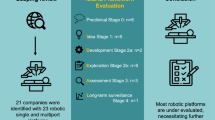Abstract
Urologic injury is an infrequent but serious complication of pelvic surgery. Training in the assessment and management of this injury might be enhanced through animated simulation. Our objective was to assess the intraoperative management of urologic injury with robotic pelvic surgery using a simulated injury animal model. We used a female domestic pig to create three types of urologic injury, which we then managed with robotically assisted surgery. An edited video of the model was assessed by 14 senior learners and 10 attending faculty. The assessments included key competencies and domains of fidelity. A scale of poor, fair, or good was utilized. The defects and repairs simulated those seen in humans, both anatomically and surgically, although deficiencies were noted. Related to fidelity of the anatomy of the ureter and bladder, lower ratings were given for some of the key competencies (determining the relationship to the trigone, ureteral mobilization, repair of all 3 injuries). The porcine model for simulation of urologic injury during robotically assisted pelvic surgery may be useful for training purposes.
Similar content being viewed by others
References
Hoffman MS (2008) How to safeguard the ureter and repair surgical injury. OBG Manage 20:16–28
Baggish M (2012) Major laparoscopic injuries: a review in two parts. J Gynecol Surg 28:315–332
Hammond I, Taylor J, Obermair A, McMenamin P (2004) The anatomy of complications workshop: an educational strategy to improve the training and performance of fellows in gynecologic oncology. Gynecol Oncol 94:769–773
Hoffman M, Ondrovic L, Wenham R, Sachin A, Murray S, Zervos E, William W, Roberts W (2009) Evaluation of the porcine model to teach various ancillary procedures to gynecologic oncology fellows. Am J Obstet Gynecol 201:116.e1–116.e3
Hoffman MS, Palmer J, Young C, Cobb A, Downes K (2014) Simulation of cystotomy repair utilizing fresh-frozen porcine bladder. J Gynecol Surg 30:141–146
Goff BA (2008) Changing the paradigm in surgical education. Obstet Gynecol 112:328–332
Hammoud MM, Nuthalapaty FS, Goepfert AR, Casey PM, Emmons S, Espey EL, Kaczmarczyk JM, Katz NT, Neutens JJ, Peskin EG (2008) To the point: medical education review of the role of simulators in surgical training. Am J Obstet Gynecol 199:338–343
Stefanidis D, Korndorffer JR Jr, Markley S, Sierra R, Scott DJ (2006) Proficiency maintenance: impact of ongoing simulator training on laparoscopic skill retention. J Am Coll Surg 202:599–603
McDougall EM, Corica FA, Boker JR, Sala LG, Stoliar G, Borin JF, Chu FT, Clayman RV (2006) Construct validity of a laparoscopic surgical simulator. J Am Coll Surg 202:779–787
Lanvin D, Elhage A, Henry B, Leblanc E, Querleu D, Delobelle-Deroide A (1997) Accuracy and safety of laparoscopic lymphadenectomy: an experimental prospective randomized study. Gynecol Oncol 67:83–87
Lentz GM, Mandel LS, Goff BA (2005) A six-year study of surgical teaching and skills evaluation for obstetric/gynecologic residents in porcine and inanimate surgical models. Am J Obstet Gynecol 193:2056–2061
Funding
This study was funded by USF Center for Advanced Medical Learning and Simulation.
Author information
Authors and Affiliations
Corresponding author
Ethics declarations
Conflict of interest
Dr. Mitchel Hoffman declares that he has no conflict of interest. Dr. Philippe Spiess declares that he has no conflicts of interest. All applicable international, national, and institutional guidelines for the care and use of animals were followed.
Ethical approval
All applicable international, national, and institutional guidelines for the care and use of animals were followed. All procedures were performed in accordance with the ethical standards of the University of South Florida Institutional Animal Care and Use Committee
Electronic supplementary material
Below is the link to the electronic supplementary material.
Supplementary material 1 (MOV 17872 KB)
Supplementary material 2 (MOV 129605 KB)
Supplementary material 3 (MOV 64017 KB)
Rights and permissions
About this article
Cite this article
Hoffman, M.S., Spiess, P.E. Simulated management of urinary tract injury during robotic pelvic surgery utilizing the porcine model. J Robotic Surg 13, 289–292 (2019). https://doi.org/10.1007/s11701-018-0852-z
Received:
Accepted:
Published:
Issue Date:
DOI: https://doi.org/10.1007/s11701-018-0852-z




